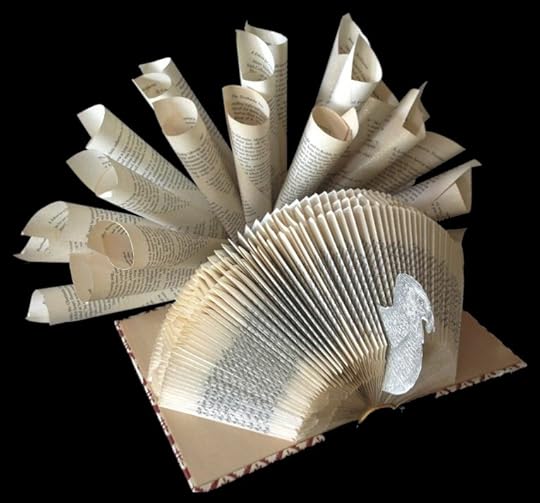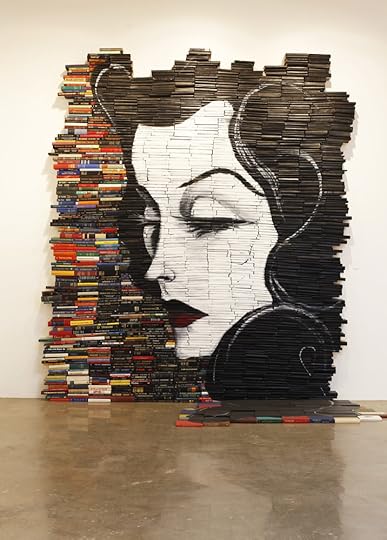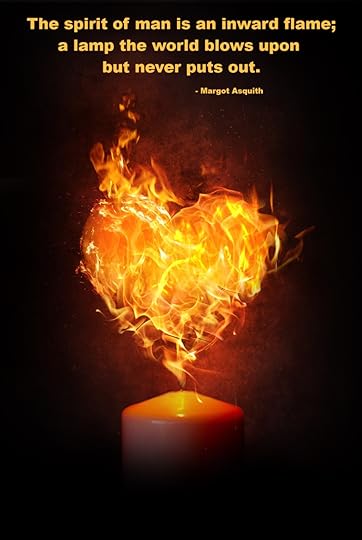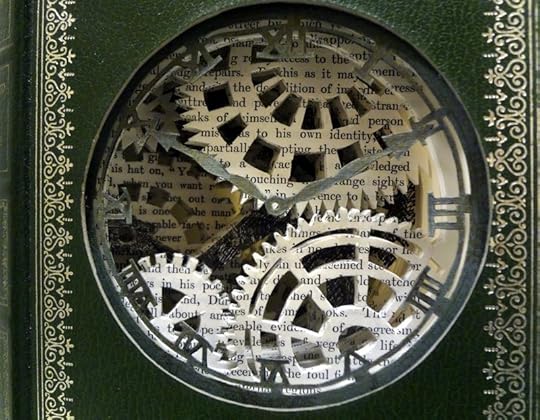B.V. Lawson's Blog: In Reference to Murder, page 152
November 21, 2018
Mystery Melange, Thanksgiving Edition
The end of the year "best" lists keep on coming. Kirkus shared the thirteen books it has chosen for "Best mystery and thrillers of 2018" and Strand Magazine compiled its list of twenty "best" books.
Meanwhile, the Goodreads Readers Choice Awards has narrowed it longlists down to finalists including ten Mystery/Thriller titles. Voting continues through November 26 with winners announced on December 4.
Janet Rudolph has updated her annual list of Thanksgiving-themed mysteries over at the Mystery Fanfare blog.
The Mystery Lovers Kitchen crew have several Thanksgiving recipes for you, including dressing, brussels sprouts with bacon, pumpkin crisp streusel, cranberry pie, and more.
The holiday issue of Mystery Scene Magazine is out, with a profile of M.C. Beaton's Agatha Raisin mystery series and the UK television show based on the novels with Ashley Jensen played Agatha. Mary Higgins Clark and Alafair Burke talk about their collaboration and the ins and outs of co-writing; Oline H. Cogdill catches up with Lou Berney to chat about his new book November Road, the follow-on to his Edgar Award-winning The Long and Faraway Gone; Craig Sisterson talks with Mindy Mejia, a rising star who has a real talent for evoking rural life in her home state of Minnesota; Kevin Burton Smith has scoured the retail landscape again to gather a bundle of holiday gifts for mystery lovers; plus more news and reviews.
Kings River Life has two Thanksgiving mystery short stories online for your reading pleasure, one by Gail Farrelly titled "Ya Never Know: A Thanksgiving Tale," and the other titled "Justice For Elijah: A Thanksgiving Mystery Short Story" by Earl Staggs.
Switchblade: Stiletto Heeled, the all female issue, is now available on Kindle. It's the first publication in the new Switchblade addition to their publishing lineup, with Lisa Douglass, the newest member of the editorial team, serving as Managing Editor.
The Washington Post's Michael Dirda took an affectionate look at the pleasures of classic whodunnits from the Golden Era, stilted dialogue, ludicrous plots, and all.
The Age profiled some of Australia's "deadliest female writers."
Something not to be thankful for: book banning is alive and well in Kuwait. The Information ministry blacklist said that the Kuwait international literary festival had banned 948 books including Dostoevsky’s The Brothers Karamazov. The information ministry has blacklisted more than 4,000 books over the past five years, including Victor Hugo’s The Hunchback of Notre Dame and One Hundred Years of Solitude by Gabriel García Márquez.
The Wall Street Journal has gotten into the gift-giving spirit early with some recommendations of collections of 1920s crime fiction, female-detective stories and more.
What do you get for the crime fiction lover who has everything? Look no further than the album "Just the Clothes on My Back" by the American roots rock band Naked Blue, which is full of tracks about Lee Child’s wide-roaming ex-forces crime buster Jack Reacher.
For those of you in the U.S. who are planning on sitting around watching TV while digesting that huge Thanksgiving dinner, there are several marathons to choose from the entire weekend, including the NCIS series (all three), Forensic Files, Criminal Minds, and CSI, among many, many more.
The latest poem at the 5-2 crime poetry weekly is "The Man Who Stole Poetry" by Anne Graue.
In the Q&A roundup John Sanford is the latest "By the Book" interview for the New York Times; and the Mystery People's Scott Butkis interviewed Alafair Burke, who has joined forces again with Mary Higgins Clark for a new book in their Under Suspicion series, You Don’t Own Me.






 Related StoriesMystery Melange
Related StoriesMystery Melange
November 19, 2018
Media Murder for Monday
 Monday means it's time for the latest roundup of crime drama news:
Monday means it's time for the latest roundup of crime drama news:
THE BIG SCREEN
Margot Robbie’s Luckychap and Dan Lin’s Rideback are developing Tess Sharpe’s novel Barbed Wire Heart for Warner Bros., with Westworld scribe Carly Wray adapting. Barbed Wire Heart follows Harley McKenna, the daughter of a meth-dealing killer who’s been groomed for the family business since she was 16. She squares off against the rival family who took her mother’s life and she must find a way to stand up to them and her fierce father without jeopardizing the lives of the abuse survivors in the women’s shelter she runs.
Paramount Pictures is in talks with with Chris Pratt to star in a relaunch of its action franchise The Saint. Based on the character in the novels by Leslie Charteris, The Saint was originally adapted into a 1940s serial and then a TV series in the 1960s starring Roger Moore. Simon Templar, known as "The Saint" is a wealthy adventurer and fixer who takes on the criminal underworld.
Aisha Tyler (24, Criminal Mind) has been set to direct Vigilante, a female-themed thriller scripted by Irwin Winkler and Jose Ruisanchez. The project is described as a socially charged #MeToo era thriller that follows the journey of a young woman who, after suffering a brutal attack, channels her anger and grief into protecting others.
Peter Sarsgaard, Maya Hawke, and Betty Gabriel have joined Liev Schreiber, Marisa Tomei, and Alex Wolff in the indie dramatic thriller Human Capital, an adaption of Stephen Amidon’s novel which is being helmed by Mark Meyers. The film centers on the lives of two families, one middle-class and one privileged, as their lives intertwine across the social divide when two of their children suddenly begin a relationship that leads to a tragic accident.
The British Independent Film Awards has set a handful of early winners including a couple of crime dramas. Psychological noir thriller You Were Never Really Here (Amazon) took Best Music for Jonny Greenwood and Best Sound for Paul Davies. Layton’s heist picture American Animals (The Orchard) won Best Editing by Nick Fenton, Julian Hart, and Chris Gill.
An official trailer was released for The Informer, starring Joel Kinnaman as an ex-con who goes undercover and intentionally gets himself incarcerated again in order to infiltrate the mob at a maximum security prison.
TELEVISION/STREAMING SERVICES
NBC has given a script commitment to Red Stick, a crime drama from bestselling author Patricia Cornwell and Sony Pictures TV. Written by Samantha Humphrey (S.W.A.T.), Red Stick is based on an idea by Cornwell and follows Dr. Annie Dodge who is summoned from New York to her hometown of Baton Rouge, LA, after the sudden death of her father, the city’s beloved coroner. Now, as she’s mourning the loss of her childhood hero, Annie finds herself reluctantly stepping into her father’s role to solve an ongoing murder while navigating the complicated waters of Bayou politics, Southern hospitality and a simmering past romance.
The peacock network also given a script commitment to The Bone Collector, based on the bestselling book series by Jeffery Deaver and the 1999 movie of the same name which starred Denzel Washington and Angelina Jolie. Written by VJ Boyd and Mark Bianculli, The Bone Collector follows Lincoln Rhyme, a retired genius forensic criminologist left paralyzed after an accident on the job. When a harrowing case brings him back to the force, Rhyme partners up with an ambitious young detective, Amelia Sachs, to take down some of the most dangerous criminals in the U.S.
Fox has given a script commitment to Puller, an hour-long drama based on David Baldacci’s bestselling John Puller book series. Written by Bones executive producer Carla Kettner, Puller is described as an action-forward procedural thriller about John Puller, an investigator with the Army’s Criminal Investigation Division. Puller, a decorated former Army Ranger, faces the most difficult case of his life when his brother, a convicted traitor, escapes from a maximum security prison. Together with Veronica Knox, an army intel specialist, Puller searches for his fugitive brother. In the book series, John and Veronica solve the most difficult of crimes while John secretly battles to restore his family honor.
Fox is also developing a female-centric Texas Rangers drama. Written by Matt Cook, the untitled project centers on Lauren Crawford Flynn, one of only two females in the legendary and notoriously tough Texas Rangers, who balances the demands of her intense, high stakes job in a male dominated world with the challenges of being a single mom to a young teenage daughter.
Joel Silver and his Silver Pictures Television have sold two crime drama projects to CBS, False Memories and Crooked Brooklyn. False Memories is inspired by Emmy Bryce’s article “False Memories and False Confessions: The Psychology of Imagined Crimes,” in Wired UK and centers on a forensic psychologist who uses her expertise in the malleability of human memory to investigate crime scenes. Crooked Brooklyn is inspired by Michael Vecchione and Jerry Schmetterer’s 2015 bestselling book Crooked Brooklyn: Taking Down Corrupt Judges, Dirty Politicians, Killers and Body Snatchers, and centers on a drive to ferret out corruption that leads to the DAs of the Brooklyn Rackets Division given badges and guns to investigate crime on the streets and prosecuting those crimes in the courtroom.
ABC has put in development the drama The Marriage Lie, inspired by Kimberly Belle’s bestselling book of the same name and adapted by writer Michael Cooney. The project centers on Iris and Will whose seven-year marriage seems idyllic. But on the morning Will flies out for a business trip to Florida, Iris’s happy world comes to an abrupt halt when she learns his name is on a passenger list not for Florida but on another headed to New York that has crashed. As Iris sets off on a desperate quest to uncover what her husband was keeping from her, the answers she finds shock her to her very core.
Netflix is working on a new adaptation of Daphne du Maurier's thriller novel, Rebecca. It tells the story of a young woman (Lily James) who, on arriving at her husband's (Armie Hammer) imposing family estate on a bleak English coast, finds herself battling the shadow of his dead first wife, the mysterious Rebecca, whose legacy continues to haunt the house. In 1940, Alfred Hitchcock directed the iconic film version that starred Lawrence Oliver and Joan Fontaine.
Amazon Studios has closed an exclusive production deal with Jason Blum’s Blumhouse Television for eight thriller genre features which will all be connected thematically. The deal marks Amazon Studios’ first ever global-direct to service deal for feature length programs.The movies will be made by a diverse group of filmmakers and is being developed out of Amazon’s movie department.
With a fifth season currently in production and set to launch next year, Amazon announced the Titus Welliver-led series of Connelly’s beloved and hardboiled LAPD detective, Bosch, will be back for a Season 6. In addition to Welliver as the jazz loving Harry Bosch, the series also stars Jamie Hector as LAPD Detective Jerry Edgar, Amy Aquino as Lt. Grace Billets, Madison Lintz as Maddie Bosch, and Lance Reddick as Deputy Chief Irvin Irving.
Netflix has opted not to renew The Good Cop, its hourlong dramedy starring Tony Danza and Josh Groban. The Good Cop starred Danza as Tony Sr., a disgraced former NYPD officer who never followed the rules. He lives with his son, Tony Jr., (Groban), an earnest, obsessively honest NYPD detective who makes a point of always following the rules. This “odd couple” become unofficial partners as Tony Sr. offers his overly cautious son blunt, streetwise advice.
CBS All Access, CBS’ SVOD and live streaming service, has given a straight-to-series order to the true-crime drama, Interrogation. Co-created by Swedish writer-producer Anders Weidemann (30 Degrees In February) and John Mankiewicz (House of Cards, Bosch), Interrogation is an original concept based on a true story that spanned more than 30 years, in which a young man was charged and convicted of brutally murdering his mother. Each episode is structured around an interrogation taken directly from the real police case files, with the goal of turning the viewer into a detective.
Hugh Grant has joined the cast of the HBO’s The Undoing, set to star opposite Nicole Kidman. Grant will play Jonathan Sachs, an acclaimed pediatric oncologist, devoted husband to Grace Sachs (Kidman) and doting father, whose past undergoes scrutiny when he suddenly disappears, leading to a chain of terrible revelations for his wife. Based on the book You Should Have Known by Jean Hanff Korelitz, the six-episode series follows Grace in the wake of a spreading and very public disaster.
Stranger Things star David Harbour has joined the cast of the Chris Hemsworth action vehicle Dhaka for Netflix. The screenplay, written by Joe Russo, centers on the underworld of weapons dealers and traffickers, where a young boy becomes the pawn in a war between notorious drug lords. Trapped by kidnappers inside one of the world’s most impenetrable cities, his rescue beckons the unparalleled skill of a mercenary named Tyler Rake. But Rake is a broken man with nothing to lose, harboring a death wish that makes an already deadly mission near impossible.
PODCASTS/VIDEO/RADIO
Kareem Abdul-Jabbar, co-author of Mycroft and Sherlock, stopped by CBS's The Talk.
Crime novelist, poet, and jazz enthusiast John Harvey was one of the latest guests on BBC Radio's Private Passions podcast, hosted by Michael Berkeley.
Beyond the Cover welcomed Jon Land, author of the new Jessica Fletcher novel, Manuscript for Murder: a Murder, She Wrote novel.
The latest episode of Writer Types featured thriller writer Lee Child, creator of the Jack Reacher series, as well as Sara Gran with her new Claire DeWitt novel, The Infinite Blacktop. Also Peter Leonard talked about keeping alive his father Elmore's creation, Raylan Givens alive in Raylan Goes To Detroit.
In the Speaking of Mysteries podcast, Wiggins is back in The Red Ribbon, H.B. Lyle’s second installment of the continuing story of Sherlock Holmes’ Irregular-in-Chief’s career in Britain’s MI-5.
Host D.P. Lyle talked about "Mood and Tone in Crime Fiction" in the latest installment of CRIMINAL MISCHIEF: The Art & Science of Crime Fiction.






 Related StoriesMedia Murder for Monday
Related StoriesMedia Murder for Monday
November 15, 2018
Mystery Melange
Maureen Corrigan of The Washington Post picked her list of "The 10 best thrillers and mysteries of 2018." Check out all of the ten titles via this link.
Amazon announced its editors’ picks of the best books of 2018 this past weekend. To check out all of the top 20 honorees, hop on over here.
Scots crime writer Val McDermid has been appointed as the new patron of the Scottish Book Trust, an organization that tries to transform lives through reading and writing. Val will lend her support to Trust to help inspire and support the people of Scotland to read and write for pleasure through programs and outreach work.
Prometheus Books, which is nearing its 50th anniversary, has decided to refocus on nonfiction titles and sold its two genre imprints to Start Publishing. One of those, the crime fiction imprint Seventh Street Books, currently has a backlist of about ninety titles including award-winning books by Allen Eskins, Adrian McKinty, Lori Rader-Day, and Terry Shames. Start Publishing began has an exclusively digital publisher but has expanded to include print editions as well. Start will publish both print and digital editions of the newly acquired Seventh Street titles.
A new book suggests that Arthur Conan Doyle based Moriarty on the real-life mathematician, George Boole.
The Guardian profiled Endless Night, one of Agatha Christie's favorite of her works that "still has shock factor." As the article author, Sam Jordison, notes, the 1967 novel isn’t so much a "whodunnit," as a "who gonna get done."
The latest issue of Mysterical-E is available online for your reading pleasure, with eleven new crime stories; Gerald So's regular column takes a look at the Cloak and Dagger TV series and more media crime notables, while Anita Page looked back at the 1997 classic, Wag the Dog; plus new book reviews from Christine Verstraete and new interviews and more.
More fun with amazing bookstores to put on your bucket list: "Living 11 Of The Dreamiest Bookstores To Get Lost In Across Canada"
The latest poem at the 5-2 crime poetry weekly is "I Believe Her" by John Kaprielian.
In the Q&A roundup, Alexander McCall Smith (author of the No. 1 Ladies’ Detective Agency series) sat down for a chat with the Globe & Mail about his writing and how, at age 70, he has no desire to slow down; the Sudbury Star spoke with Sam Wiebe who edited the latest addition to the Akashic Books noir series titles, Vancouver Noir; and Writers Tell All welcomed Jeff Abbott talking about his novel The Three Beths and what it was like trying to contine to write after his house burned down.






 Related StoriesMystery Melange
Related StoriesMystery Melange
November 12, 2018
Media Murder for Monday
 Monday greetings to all and welcome to your latest crime drama roundup:
Monday greetings to all and welcome to your latest crime drama roundup:
THE BIG SCREEN
A Breaking Bad movie from original series creator Vince Gilligan is set to begin production in New Mexico later this month. Further details about the film are being kept under wraps, although it's said to follow the escape of a kidnapped man and his quest for freedom. What's unclear is whether any of the show’s original characters are expected to return or if the project is planned for a theatrical release or will air on television.
The live-action film version of the 1960s pop icon/animated TV series Jonny Quest appears closer to becoming a reality after Lego Batman Movie director Chris McKay has been hired to direct the project for Warner Brothers. The story centers on the adventurous boy hero Jonny Quest who travels around the world with his scientist father, his adopted brother Hadji, and their former secret agent bodyguard, Race Bannon, to solve world-threatening mysteries. An individual with knowledge with of the project told TheWrap that a major movie star is being eyed to play Race Bannon.
J.J. Abrams’ Bad Robot has optioned an untitled feature pitch from The Crown writer Ed Hemming following a competitive auction. Plot details are being kept under wraps, although it's understood to be a high school-set thriller in the present day with a socially relevant twist.
Allison Janney has landed the lead role in the thriller Lou, another project being set up at J.J. Abrams’s Bad Robot Productions. Anna Foerster (Underworld: Blood Wars, Outlander) will direct the dramatic thriller that follows a tough elderly woman living on a remote island who is recruited by a neighbor to help her find her kidnapped daughter. Janney will play a rule-breaking woman with a tough shell and abilities as a tracker.
Saban Films has acquired North American rights to American Dreamer, Derrick Borte’s thriller starring Jim Gaffigan as a down-on-his-luck rideshare driver who gets in way over his head with drug dealers and a kidnapping. Saban plans a theatrical release for the pic, which had its world premiere at the Los Angeles Film Festival.
TELEVISION/STREAMING SERVICES
Less than a month after announcing the upcoming seventh season of Orange Is the New Black would be its final run, producers Lionsgate Television are already mulling a potential sequel to the series created by Jenji Kohan and starring Taylor Schilling, Laura Prepon, Uzo Aduba and Danielle Brooks. Orange Is the New Black, which is inspired by Piper Kerman's memoir of the same name, bowed to critical acclaim in 2013.
Emmy-winning director Susanne Bier (The Night Manager) has signed on to direct all six episodes of The Undoing, the network’s high-profile limited series written by David E. Kelley and starring Nicole Kidman. Adapted from Jean Hanff Korelitz’s book You Should Have Known, The Undoing centers on Grace Sachs (Kidman), who is living a seemingly perfect life - a successful therapist with a new book, a devoted husband, and a young son in an elite private school. But a violent death followed by her husband going missing threatens to tear her perfect world apart.
Emmy-winning The Americans star Matthew Rhys is in talks to take on the role of the iconic titular lawyer in HBO's planned Perry Mason reboot. Rhys played Russian spy Philip Jennings for six seasons on FX's The Americans, and this year the role scored him his first career Emmy after three prior nominations.
Jeremy Irvine (War Horse) and Brian J. Smith (Sense8) have been cast as two of the leads of USA Network’s straight-to-series drama Treadstone, an offshoot of Universal’s Bourne franchise, from creator Tim Kring and Universal Cable Productions. Written by Kring, Treadstone explores the origin story and present-day actions of a CIA black ops program known as Operation Treadstone — a covert program that uses behavior-modification protocol to turn recruits into nearly superhuman assassins.
Robin Givens is set to appear on the ABC legal drama The Fix in the recurring role of Julianne Johnson, the loyal ex-wife of Sevvy (Adewale Akinnuoye-Agbaje). The Fix follows Maya Travis (Robin Tunney), an L.A. district attorney who suffers a devastating defeat when prosecuting Sevvy, an A-list actor for double murder. With her high-profile career derailed, she flees for a quieter life in Washington. But when Sevvy falls under suspicion for another murder eight years later, Maya is lured back to the DA’s office for another chance at justice.
Max Greenfield is the latest original Veronica Mars cast member set to reprise their role in the upcoming Hulu revival. Also joining the cast of the eight-episode limited series, scheduled to premiere in 2019, is Patton Oswalt. Greenfield’s Leo D’Amato was the new Sheriff’s Deputy when he recurred on the first three seasons of Veronica Mars. In the followup movie, Leo was a detective at the San Diego Police Department who helped Veronica (Kristen Bell) in the Susan Knight murder investigation.
Less than a month after its premiere on ABC, The Rookie is getting a full-season order. The cop drama premiered in mid-October to ratings that surpassed its time period from previous shows in that slot.
TNT's hitman series Good Behavior has been canceled after two seasons. The series was based on books by Blake Crouch and starred Michelle Dockery as Letty, a con artist released from jail on good behavior, who accidentally becomes entangled with an assassin named Javier played by Diego Botto.
PODCASTS/VIDEO/RADIO
Showtime is launching a companion podcast for its upcoming limited series from Ben Stiller, Escape at Dannemora, that will delve into the real-life events that inspired the drama. The limited series, which is directed and executive produced by Stiller, is based on the 2015 prison break from Clinton Correctional Facility. The podcast, which is produced by Wondery’s Real Crime Profile, will dive deeper into the real-life events and feature interviews with cast-members, real people involved in the case and the creators.
In the latest Crime Friction episode, hosts Jay Stringer and Chantelle Aimee Ausman were joined by Lou Berney to talk about hats, the sixties, and his new book, November Road.
The MysteryRats Maze podcast featured the first chapter of the mystery novel The Plunge by Nancy G. West, read by local actor Ariel Bennett.
Host Debbi Mack welcomed crime writer Dana King, author of the Nick Forte & Penns River Series, for an interview on the Crime Cafe.
Regular Read or Dead host Rincey Abraham was joined by guest host Liberty Hardy to "basically just rave about the amazingness that is Agatha Christie."
The latest Spybrary podcast featured a chat with author Merle Nygate about her first espionage novel, The Righteous Spy.
THEATER
A new Sherlock Holmes adaptation is heading to The New Theatre Royal, Portsmouth, from November 15-17. Nick Lane adapted Arthur Conan Doyle's The Sign of Four for the stage, and says of the production, "Some of it is set during the Indian rebellion of 1857 – the book does go back 35 years in time from when it was written to talk about what transpired and why the crime at the centre of the novel happened, so there’s quite a bit of exposition. You have to try and find ways to make it fun for the audience to watch and visually interesting."






 Related StoriesMedia Murder for Monday
Related StoriesMedia Murder for Monday
November 10, 2018
Quote of the Week
November 9, 2018
FFB: Voice Out of Darkness
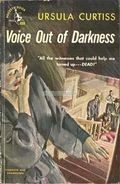 Ursula Reilly Curtiss, born in 1923, came into the world with fairly impressive crime-fiction genes. Her mother, Helen Reilly, her sister, Mary McMullen, and her brother, James Kieran, all wrote mysteries. Curtis didn't start out that way, working first as a columnist for the Fairfield, Connecticut News in 1942, at age 19, followed by a stint as a fashion copy writer. She began writing mystery/suspense novels, full-time at that, when she married John Curtiss in 1947 (the marriage no doubt helping her financial circumstances enough to give her that opportunity). Her first book, Voice Out of Darkness, won the Red Badge Award for the best new mystery of 1948.
Ursula Reilly Curtiss, born in 1923, came into the world with fairly impressive crime-fiction genes. Her mother, Helen Reilly, her sister, Mary McMullen, and her brother, James Kieran, all wrote mysteries. Curtis didn't start out that way, working first as a columnist for the Fairfield, Connecticut News in 1942, at age 19, followed by a stint as a fashion copy writer. She began writing mystery/suspense novels, full-time at that, when she married John Curtiss in 1947 (the marriage no doubt helping her financial circumstances enough to give her that opportunity). Her first book, Voice Out of Darkness, won the Red Badge Award for the best new mystery of 1948.
Rather than penning police procedurals like her mother, Curtiss focused on the type of story where an innocent bystander gets pulled reluctantly into becoming an amateur sleuth — against a backdrop of seeming domestic calm, with layers of evil hiding behind family secrets and familiar faces. Her protagonists were usually female, except for works like 1951's The Noonday Devil where the main character is a man who learns his brother's death as a Japanese POW was carefully planned by a fellow prisoner.
Voice Out of Darkness falls into the female-protagonist camp, where we find that thirteen years prior to the events of the book, Katy Meredith lost her foster-sister, Monica, in a skating accident. Although Katy tried to save Monica, Monica's last words were "Katy pushed me." Katy thought she'd escaped both her home town and the horrors of Monica's death by moving to New York, until she starts receiving threatening notes in the mail. At first she wonders if someone else near the ice that day overheard Monica's words and is trying to blackmail her, but when Katy returns to her childhood home, she finds evidence of a calculating killer whose sights are now set on her.
Curtiss has moments of crisp observations in her writing, such as the following character study:
She was disconcerted, in the midst of her apologies for lateness, by Lieutenant Hooper's mild and wren-like appearance; he looked, she thought, like a portrait of a suburban traveller. Rubbers. Plaid woollen muffler, an air of having been assembled, eyed critically, and finally dismissed on the 8:32 by a bustling, dutiful wife. Except for his eyes: shrewd, steady, impartial as jewellers' scales.
or this excerpt about Fenwick, Connecticut, Katy's home town:
[It] had its replicas all over the New England coast. It lay sheltered in a tumble of windy hills, its architecture a blend of pure old Colonial and the raw new bones of housing developments. Its chief prosperity came from the summer visitors who came to splash and play in its wide blue crescent of Sound and laugh delightedly at its ancient moviehouse. Its chief crop was gossip, sown and grown with zest...
Curtiss' strengths are in her characterizations, setting and pacing, the novel being a quick read, which helps make the slight thinness and predictability of the plot (at least by 21st-century eyes looking backward), not much of a distraction. Curtiss later had two of her books, made into movies, I Saw What You Did from 1965 (based on Curtiss' novel Out of the Dark (not to be confused with the similarly-named today's Forgotten Book offering), starring Joan Crawford, and 1969's What Ever Happened to Aunt Alice?, based on the author's novel The Forbidden Garden, featuring Geraldine Page and Ruth Gordon. Curtiss also wrote the screenplays for a couple of television episodes of Detective and Climax Mystery Theater.







November 8, 2018
Author R&R with Libby Fischer Hellmann
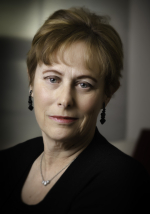 Libby Fischer Hellman has published thirteen novels and twenty short stories including suspense mysteries, historicals, PI novels, amateur sleuth tales, police procedurals, and even a cozy mystery. Her first novel, An Eye for Murder, which features Ellie Foreman, a video producer and single mother, was released in 2002 and nominated for several awards. Publishers Weekly called it a "masterful blend of politics, history, and suspense." In 2008 Libby introduced her second series featuring hard-boiled Chicago PI Georgia Davis, with the latest book in that installment just released, High Crimes:
Libby Fischer Hellman has published thirteen novels and twenty short stories including suspense mysteries, historicals, PI novels, amateur sleuth tales, police procedurals, and even a cozy mystery. Her first novel, An Eye for Murder, which features Ellie Foreman, a video producer and single mother, was released in 2002 and nominated for several awards. Publishers Weekly called it a "masterful blend of politics, history, and suspense." In 2008 Libby introduced her second series featuring hard-boiled Chicago PI Georgia Davis, with the latest book in that installment just released, High Crimes:
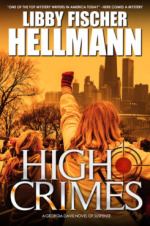 How do you solve a murder when there are 42,000 suspects? That’s the task facing Chicago PI Georgia Davis, hired to hunt down those ultimately responsible for the assassination of Resistance leader Dena Baldwin at a demonstration fourteen months after the 2016 election. The gunman, on a hotel rooftop near Grant Park, dies within minutes of the shooting. As Georgia sifts through Dena’s 42,000 Facebook followers, she discovers that unknown enemies hiding behind fake profiles have infiltrated the group. She finds others who will do whatever it takes—including murder—to shield right-wing, wealthy elites. When Georgia begins piecing together the facts, relatives of both victims mysteriously disappear, and the danger escalates. Threats and bruises have never frightened Georgia, but she’s side-swiped by the sudden reappearance of the mother who abandoned her when she was a child. Can she survive an emotional family crisis at the same time she pursues killers whose only goal is to protect themselves?
How do you solve a murder when there are 42,000 suspects? That’s the task facing Chicago PI Georgia Davis, hired to hunt down those ultimately responsible for the assassination of Resistance leader Dena Baldwin at a demonstration fourteen months after the 2016 election. The gunman, on a hotel rooftop near Grant Park, dies within minutes of the shooting. As Georgia sifts through Dena’s 42,000 Facebook followers, she discovers that unknown enemies hiding behind fake profiles have infiltrated the group. She finds others who will do whatever it takes—including murder—to shield right-wing, wealthy elites. When Georgia begins piecing together the facts, relatives of both victims mysteriously disappear, and the danger escalates. Threats and bruises have never frightened Georgia, but she’s side-swiped by the sudden reappearance of the mother who abandoned her when she was a child. Can she survive an emotional family crisis at the same time she pursues killers whose only goal is to protect themselves?
Libby stops by In Reference to Murder to talk briefly about writing the book and offers up an excerpt:
RESEARCH FOR HIGH CRIMES
The short answer is that I didn’t do much research for this book. The daily news cycle provided most of what I needed. Even before the election, I started following a few people on Twitter with contacts in the IC (Intelligence Community). Through piecing together what they were and were not reporting, I was able to construct an overview of what has become the most corrupt, incompetent administration in American history. I also joined a Facebook group (featured in the novel itself) that provides a daily compendium of news stories and articles that deepened my knowledge. And I followed blogs like Amy Siskind’s Weekly List of creeping authoritarianism and the death of democracy. Fun stuff, right?
Having said all that, however, there were a couple of situations for which I needed help. I talked to an ethical hacker to construct how to send an anonymous email that couldn’t be traced, and I also talked to a scientist who told me how to set up the explosion that kills the killer.
BOOK EXCERPT
Georgia rose. “Erica?”
The woman nodded. Her black hair, threaded with gray, was pulled back into a messy ponytail. She wore jeans, a wool jacket, and snow boots despite the absence of snow. Her neck was long and graceful, but her tight expression made her otherwise smooth features look sharp and out of place, as if they were surprised to find themselves arranged on her face. She was pale and thin, on the way toward emaciated. Grief, likely.
“I’m Georgia Davis.”
The woman, probably in her fifties, gave her a slight nod and gestured to the younger man beside her. “This is my son, Jeffrey. Dena’s brother.”
That Dena had a brother was news to Georgia. It hadn’t been mentioned in the media. Jeffrey was several inches taller than his mother, but just as slim. Somewhere in his thirties. He shared his mother’s dark eyes and hair, minus the gray. His face held a somber, soulful expression.
“He’s as devastated as I am. We both want to get to the bottom of this.”
Get to the bottom of what? Three people had died, including Dena. A dozen more wounded. The shooter had been found—dead from an IED explosion on the roof of a hotel directly across from Grant Park. An open-and-shut case, or so officialdom proclaimed. Domestic terrorism. Tick off yet another massacre to add to the legacy of American gun violence.
Georgia reined in her impatience. “Would you like some coffee? It’s on me.”
“I—uh—tea would be nice.”
A few minutes later, with cappuccino and a pastry for Georgia, the same for Jeffrey, and tea for Erica, they settled into chairs. Jeffrey cleared his throat. Erica sipped her tea. She looked dazed, almost lost. She was clearly struggling. An unusual tug of protectiveness came over Georgia. She gentled her voice as she prompted Erica.
“You said, ‘get to the bottom of this.’ What do you mean?”
Erica’s chest rose and fell. She took another sip of tea. “I assume you’re up to speed on the events of—of Dena’s death.”
Georgia nodded. It was still the top story everywhere. A year had passed since the election of the most unpopular president ever, and despite a core base of supporters, millions were demanding he be removed from office. The president and his administration were incompetent, corrupt, and dangerous. The rumors were that Chicago bookies wouldn’t take any more bets about his odds for survival. A special counsel was investigating.
Erica played with her spoon. “So let me tell you about Dena. She is—was—a left-wing progressive, and she supported Bernie until the convention. Afterwards, she switched to Hillary. She volunteered, rang doorbells in Wisconsin, made phone calls. She organized a rally in Evanston and even put together a carpool to drive seniors to the polls.” She shifted. “The morning after the results were in, she refused to believe them. Later that day she created a Facebook group, ResistanceUSA.”
“Wait. Are you saying she founded the group?”
A wan smile came across Erica’s face. “That’s right. She believed that the vote, particularly in the midwest swing states, had been manipulated by Russia. She wasn’t alone: others were—and still are—alleging it too. The group exploded, and by the end of the year, there were nearly forty-two thousand members.”
“Forty-two thousand people in seven weeks?”
Erica nodded. “Her energy never flagged. Within six months, she was a national figure. She was one of the first to call out every misstep by the new administration, every injustice, every example of creeping authoritarianism, every risk to our democracy. She was in the middle of expanding her ‘repertoire’ when she—died. She had begun to speak out about other issues. The dangers of fracking, the criminality of the new administration, the mess he’s made with our foreign allies. She’d really come into her own. It’s as if she was born to do this. Of course, in the process she made enemies.”
“Such as?”
“There were the bots—you know—know—automated tweets and Facebook messages that roll out whenever a specific subject is raised. Anyway, hundreds, maybe thousands of bots trolled her online.” Erica let out a world-weary breath. “Then there were the real trolls. Human crazies, I call them.”
Georgia nodded. Like mutant viruses, they had invaded the Internet to sow discord and chaos wherever possible.
“They accused her of lying, of propaganda, of being a traitor to the country. Some people even accused her of being a Russian spy working undercover.”
“Although how they could, given the administration’s complicity with Russia, is nuts,” Jeffrey cut in.
Erica nodded in acknowledgment. “Still, Dena was in her element. She thrived on allies and adversaries alike. When she wasn’t appearing on TV, she was organizing, bringing new converts to the group.”
Georgia’s eyebrows went up at the word “converts.” Erica caught it. “Yes, it may have started as a cult, but it grew so big so fast that it became a movement. Dena is—was very persuasive.” Her smile held a mix of pride and sorrow.
“So, last fall she and her crew decided to organize a grass-roots demonstration. They used the Facebook group to spread the She called for a million people to come out. Privately, she hoped there would be at least a thousand.”
“For what reason?”
“January marked a year since the inauguration, but in that short time so much of our country and policies are now unrecognizable. She wanted people to use their First Amendment rights to let the traitor know that what he’s doing and what he represents are not okay.”
“She succeeded,” Georgia said.
Another sad smile curled Erica’s lips. “It was amazing! Police estimated over two hundred thousand people came to Grant Park.” Her smile faded.
Georgia understood. There was no need to repeat the rest. A sharpshooter with a .223 Bushmaster rifle equipped with a bump stock had opened up, killing Dena, group member DJ Grabiner, and a protestor in the front row. Her second-in-command, Ruth Marriotti, along with a dozen others, had been wounded. Chicago cops tracked the gunman to the roof of the White Star Hotel twenty-two minutes later, where they discovered he’d blown himself up with what they later learned was a pipe bomb. Why he hadn’t used the Bushmaster to off himself was still unknown.
The shooter, Scott Allen Jarvis, had materialized seemingly out of nowhere. He was raised on an Iowa farm, but the family was forced to sell when Jarvis was seventeen. He moved to Iowa City for college but never graduated. His parents died in a house fire soon after he left home, leaving only Jarvis and his younger sister, Katherine. He enlisted in the army and survived two tours in Afghanistan and one in Iraq. Afterward he resurfaced in Rogers Park, a neighborhood on Chicago’s North Side, where he lived with his sister and was unemployed much of the time.
Law enforcement and the media scoured his history in the hope of tying him to some kind of radical terrorist group but didn’t find anything. It was as if the guy dropped in from another planet. That didn’t deter cable news, of course, hungry for any scrap of information, meaningful or not. They replayed the video of the shooting and the simple service that passed for Jarvis’s funeral so often that Georgia had to turn the TV off. She could only guess how it affected Erica.
Now Erica’s eyes filled. She swiped at them with her napkin.
Georgia squeezed Erica’s hand. Jeffrey Baldwin cleared his throat. Georgia glanced over. He looked like he was struggling to control his emotions.
Erica swallowed, then picked up her teaspoon, stirred her tea, replaced the spoon on the saucer. Finally, she looked up, and Georgia asked, “Why do you think your daughter was targeted for murder?”
Excerpted from HIGH CRIMES © Copyright 2018 by Libby Fischer Hellmann. Reprinted with permission of the author. All rights reserved.
You can read more about Libby and High Crimes via her website and follow Libby on Facebook and Twitter.






 Related StoriesAuthor R&R with Jay A. GerzmanAuthor R&R with J.L. AbramoAuthor R&R with J.J. Hensley
Related StoriesAuthor R&R with Jay A. GerzmanAuthor R&R with J.L. AbramoAuthor R&R with J.J. Hensley
November 7, 2018
Mystery Melange
The shortlist was announced for a controversial new prize which recognizes thriller novels in which no women are beaten, stalked, sexually exploited, raped or murdered. The Staunch Book Prize was founded by Bridget Lawless in order to create an alternative to the “overload of violence towards women in fiction.” The six nominations include Anna Porter’s The Appraisal; If I Die Tonight by A L Gaylin; East of Hounslow by Khurrum Rahman; On the Java Ridge by Jock Serong; The Kennedy Moment by Peter Adamson; and Cops and Queens by Joyce Thompson, who is currently seeking a publisher.
Ruth McIver has won the Richell Prize for Emerging Writers for her "atmospheric and chillingly entertaining" crime novel, I Shot the Devil. The Richell Prize, supported by Hachette Australia, Guardian Australia and the Emerging Writers’ festival, was established in 2015 and is open to emerging writers of both fiction and narrative non-fiction. The winner receives $10,000 and a 12-month mentorship with publisher Hachette Australia.
The 10th Annual Goodreads Choice Awards have announced the contenders, including the twenty semifinalists for Best Mystery & Thriller. Readers can vote during the process to weed the lists down to semifinalists and the finalists, who will be announced on December 4. To see the list of all fifteen books and to vote, hop on over to this Goodreads link.
Several authors are in an effort to raise funds for the charity Freedom from Torture. Along with Margaret Atwood, Julian Barnes, and others, thriller writer Lee Child is also offering a chance to name a character in his next book, with money raised from the auction used to help survivors of torture rebuild their lives. "Torture victims are the most damaged and demoralised people among us, so any move to embrace, console and help them is to be applauded and supported," Child said of his decision to choose this above other charity requests he receives.
Suspense Magazine is dedicating the fall issue to the late Anthony Bourdain, who was not only a travel and food journalist but also a crime fiction author. The magazine speaks with Joel Rose, Bourdain's co-writer and long time friend, on the graphic novel, "Hungry Ghosts." The issue also has an interview with former Federal Prosecutor and author Allison Leotta; Dennis Palumbo offers up, "When your writing doesn't love you back"; plus, Kaye George, J.B. Toner, Phillip Frey and John Sims-Jones share exclusive short stories.
Thriller writer James Patterson has launched an interactive novel titled The Chef in the UK with Facebook's Creative Shop and experiential content producer 1stAveMachine. Designed for use on mobile and social media, the adapted novel's narrative unravels in a series of interactive audio and visuals in Facebook Messenger. It reads like a chat conversation, but at key moments, the narrative switches to a video, image, or audio recording.
Dr. Rachel Franks, an instructor with a Ph.D in crime fiction, created a brief primer on Australian Crime Fiction for the blog Punk Noir Magazine.
Rare-book theft has been in the news a lot lately, but Raptis Rare Books in Palm Beach, Florida, is the first bookseller in the United States to employ a new loss prevention technology known as synthetic DNA. The technology comes from SelectaDNA, whose vice president Joe Maltese, explained, "Each application of Synthetic DNA generates a unique code, providing clients with the ability to identify and recover lost or stolen rare books." Raptis places a letter R in each of their books, "stamped" in the synthetic DNA serum, which helps them identify each unique item. The serum stamp can last five years inside of a book and can also be incorporated into an alarm system that sprays attempted burglars, leaving a trace on their skin that can be identified up to six weeks later.
As if you didn't need more reasons to like Canada's personable Prime Minister, Justin Trudeau, he dressed up as Sir Arthur Conan Doyle's beloved character Sherlock Holmes for Halloween, donning the fictional detective's signature deerstalker hat, pipe, and clue-hunting magnifying glass.
The latest poem at the 5-2 crime poetry weekly is "Trump and the Mail Bombs" by Robert Cooperman.
In the Q&A roundup, Promoting Crime Fiction blog host Lizzie Hayes chatted with TV journalist and women's fiction author Kate Helm about first crime novel, The Secrets You Hide; Criminal Element spoke with Julie Hyzy about her latest novel, Virtual Sabotage, which marks her transition from cozies to thrillers; and the Mystery People welcomed Timothy Hallinan, promoting the release of Nighttown, the latest book in his Junior Bender series.






 Related StoriesMystery Melange
Related StoriesMystery Melange
November 6, 2018
Today's the Day
November 5, 2018
Media Murder for Monday
 Welcome to the first post-time-change edition of Media Murder, with the latest roundup of crime drama news:
Welcome to the first post-time-change edition of Media Murder, with the latest roundup of crime drama news:
THE BIG SCREEN
Mel Gibson is teaming up with Charlie Hunnam and Eiza Gonzalez for Waldo, the action-packed thriller from Brit filmmaker Tim Kirkby, best known for directing episodes of Veep. The film is based on the novel Last Looks by Howard Gould and follows the brilliant but disgraced former LAPD detective Charlie Waldo (Hunnam), currently living the life of a minimalist in the woods. His quiet life comes to a startling halt when he is roped back into working as a private eye to investigate the murder of an eccentric TV star’s wife.
Dev Patel has been set to make his feature directing debut with action revenge pic Monkey Man. The Oscar nominee will also star in the film, which follows the Kid (Patel) who emerges from prison to take on a world enmeshed in corporate greed and eroding spiritual values. Thunder Road producer Basil Iwanyk calls it a “vibrant, thrilling and above all entertaining story.”
A24 announced it has picked up North American rights to the war thriller, The Kill Team, starring Nat Wolff and Alexander Skarsgard. The project follows a young soldier in the U.S. invasion of Afghanistan who witnesses other recruits killing innocent civilians and considers reporting them to higher-ups as the heavily-armed, increasingly violent platoon becomes suspicious that someone in their ranks has turned on them.
Noomi Rapace (the Millennium series) has been set to star in the thriller The Secrets We Keep, which has Joel Kinnaman (Suicide Squad) also in talks to join. Yuval Adler will direct from a script by Ryan Covington. Rapace will play Maja, a woman rebuilding her life along with her husband Dobie in New York after WWII. When they encounter an eerily familiar man their life starts to unravel. They wonder, could this be the officer who was one of their chief tormentors at the concentration camp Birkenau all those years ago?
Chloë Grace Moretz and Jack O’Connell will play Bonnie and Clyde in Kike Maillo’s Love Is a Gun, based on the book Go Down Together: The True, Untold Story of Bonnie and Clyde by bestselling author Jeff Guinn. Oscar nominee Shelton Turner (Up in the Air) wrote the screenplay, while Johnny Newman (Narcos) added revisions. Parker and Barrow gained renown during the Great Depression as they committed multiple bank and store robberies from 1931 to 1935. They are believed to have killed at least nine police officers before they were slain in Louisiana.
TELEVISION/STREAMING SERVICES
The Watch, based on Terry Pratchett’s Discworld novels, has landed an eight-part series order at BBC America. The network describes the show as a “punk rock thriller” inspired by the City Watch subset of Discworld novels. The character-driven series centers on Terry Pratchett’s misfit cops as they fight "to save a ramshackle city of normalized wrongness, from both the past and future in a perilous quest."
NBC has put in development Einstein, based on the popular German series, from writer Michael Reisz (Shadowhunters), Carol Mendelsohn, Tariq Jalil’s Intrigue Entertainment and Universal TV. Written by Reisz, Einstein follows a whip-smart, smooth-talking and illegitimate descendant of Albert Einstein who is recruited by the police for his skills at solving particularly complex cases.
The Disney-owned cable channel Freeform announced it's working on an adaptation of Stephen King's novel Joyland. The project tells the story of Devin, a college student who takes a summer job at an amusement park in a North Carolina tourist town where he confronts the legacy of a vicious murder, the fate of a dying child and the way both will change his life forever.
NBC has put in development an LAPD police drama from writer Kevin O’Hare, The Brave creator Dean Georgaris, Keshet Studios and Universal TV. Written and executive produced by O’Hare, the untitled project is based on police pilot programs in major U.S. cities. The drama follows an unlikely group of LAPD officers and detectives incentivized to live and become active members in the community they patrol, all in hopes of changing perceptions and reducing violence.
BBC Studios is developing a high-end drama based on the real-life story behind the murderous Lady Macbeth, which is set before the Shakespeare play and tells the epic and violent tale of Lady Macbeth from the female perspective, when she was Gruoch Ingen Boite, married to Gille Coemgáin, the King of Mormaer.
McMafia producer Cuba Pictures is developing a TV adaptation of Lesley Kara's debut novel, The Rumour, a story loosely based on the real-life case of British child killer Mary Kill. The book, which is set to be published in December, starts when single mother Joanna hears a rumor at the school gates that a notorious child killer is living under a new identity in their sleepy little town of Flinstead-on-Sea. How dangerous can one rumor become? And how far will Joanna go to protect her loved ones from harm when she realizes what she’s unleashed?
Ryan Hansen is officially on board for Hulu’s Veronica Mars revival reprising his role of Rick Casablancas. He joins star Kristen Bell and series creator Rob Thomas, along with a slew of other show alums, for the streamer’s eight-episode run.
William Shatner is returning at the host of Rescue 911, a reboot of the CBS series that ran from 1989 to 1996. The show featured real footage and reenactments of 911 call emergencies, and the new version would have some updates, including a new weekly, two-hour format offering a live look at first responders taking real emergency calls every week.
Investigation Discovery has ordered a six-part crime series about cold case murders in small towns from British producer Britespark Films. Welcome To Murdertown follows the baffling murder mysteries where it’s not just one person who’s hiding something – it’s everybody. From small towns and tight-lipped communities to tight-knit families, investigators must penetrate a wall of silence to crack the case.
HBO released a trailer for the upcoming third season of True Detective, which stars Mahershala Ali as an Arkansas police detective who can’t stop thinking about the two children who went missing 30 years prior. Costarring with Ali is Stephen Dorff as Hays’ partner on the case.
PODCASTS/VIDEO/RADIO
Crimereads profiled the event in 1958 when the BBC asked Ian Fleming to “interview” his eminent friend, Raymond Chandler, on Chandler’s 70th birthday. The interview is broken down into four audio segments with some of the transcripts.
Speaking of Mysteries welcomed Henry Porter to chat about Firefly, his new novel which is a classic thriller—with a twist.
Lynda La Plante has shaped crime fiction writing over the course of the last 35 years, and she spoke with the Ray Darcy Show about her enduring career.
In the latest edition of Crime Cafe, host Debbi Mack spoke with David Malcolm about his novel, The German Messenger, a historical espionage story.
Crime Novelist and The Deuce Creator George Pelecanos stopped by Wisconsin Public Radio to discuss his latest novel, The Man Who Came Uptown, and the author's history of using blue-collar stories in his work.
D.P. Lyle's latest episode of his podcast, CRIMINAL MISCHIEF: The Art & Science of Crime Fiction, focused on "Famous and Odd DNA Cases."
Lea Wait was the featured guest on Destination Mystery. Wait is the author of historical books for young people and the cozy Antique Print Mystery Series for adults.






 Related StoriesMedia Murder for Monday
Related StoriesMedia Murder for Monday
In Reference to Murder
- B.V. Lawson's profile
- 201 followers


